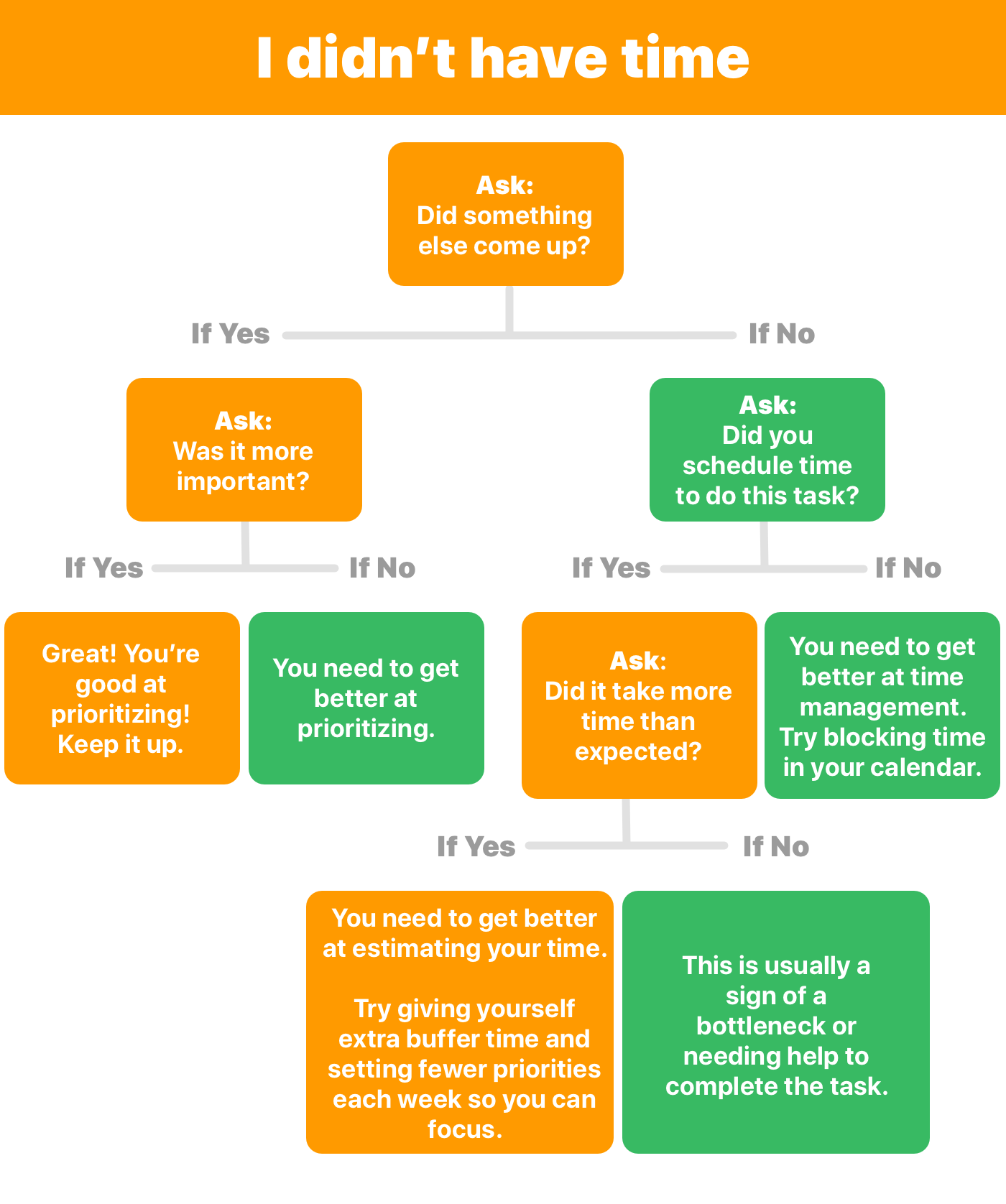“I didn’t have time to do that” was something I used to hear quite frequently in our Friday status meetings as we reviewed our top priorities for the week and whether or not we accomplished them. Sometimes even I said that myself.
The problem with “I didn’t have time to do that”
The problem with “I didn’t have time to do that” is that it’s a lie. This hard reality is something I’ve had to learn even for myself. Everyone has the same amount of time in their day. The truth is that you didn’t accomplish that thing you said you would either because you didn’t prioritize accordingly, you didn’t estimate time effectively, or something else came up and you chose to focus on that instead.
Any one of these reasons is okay. You can get better at prioritizing, you can get better at estimating time, and you can get better at making more deliberate decisions. The problem is when you don’t realize you need to get better at one of these things and you continue to blame the fact that you didn’t accomplish your priorities on not having enough time.
If you want to accomplish your goals each week and hear that your team is succeeding in completing their key priorities each week as well, read on to find out how we got better at doing this as a team.
Step 1: Building Awareness
The first step in overcoming the “not enough time” fallacy is to train yourself and your team to be more aware of how they’re managing their time. When someone on my team sets their top 3-5 priorities for the week and ends the week without completing them, I ask them, “Did something else come up that was more important?”
This question makes you evaluate if there was a bottleneck or fire that was more important than that priority. If the answer is yes, great! It shows they prioritized effectively or identified a bottleneck that needs to be resolved and that becomes the more immediate priority.
If the answer is no, then the next question I ask is, “Did you set time aside for this priority?” Usually, the answer is no. This is important. This is where awareness happens. This is the realization that the problem isn’t time, it’s time management.Once you’ve achieved awareness and clarity on the root problem, you can take the next step to resolve it.
As G.I Joe says, “Knowing is half the battle.”
Here is a flow chart to help you identify the root problem as to why a priority was not accomplished and what to do about it.
Step 2: Getting Better At Prioritizing
After you’ve established that the root problem is time management, you can start to get better at prioritizing by being more deliberate about where you spend your time.
When someone on my team (or even myself) admits that they didn’t set aside time for their key priorities during the week, I encourage them to use the technique of time-blocking. This is where you take your top 3-5 priorities for the week and block time in your calendar for each of those tasks.
There are a few benefits to this habit.
The first benefit is it helps you ensure you have time to do your high priority actions items. It removes the problem of getting dragged into your inbox or stuck fighting fires. Emails will continue to flood your inbox and fires will continue to come up. But when you time-block, it forces you to ask yourself, “Is this email or fire more important than the priority that I planned on working on right now?”
In some cases, that fire or email may be more important than the priority you planned at the start of your week. That’s okay, as long as you’re being deliberate about the decision to say no to that priority in order to fight that fire or deal with that email.
The second benefit of time-blocking for high priority tasks is that it allows you to be deliberate about when you choose to focus on high priority tasks. For example, I’m a morning person so I purposefully block time in my calendar for tasks, such as writing or work that involves analytical thinking in the morning. For tasks that involve creative problem solving or collaborating, I perform best at those tasks in the afternoon, so I’ll try to schedule brainstorming meetings or problem-solving tasks for the afternoon. By being deliberate about where I schedule time for certain priorities, I can make sure I’m optimizing my productivity for those tasks.
The third benefit of time-blocking is that it helps you get better at estimating your time. I use my Daylite calendar to block time for tasks and I assign them a category such as “marketing”, “strategy”, or “writing,” and each has a different colour. This way I can review my calendar week over week and see where most of my time is spent.
This allows me to get better at planning ahead and helps me get better at estimating certain types of tasks in the future. For example, I used to set 2 hours aside for writing a blog. I’d then update the appointment after the fact to see how much time was actually spent. After weeks of reviewing the data in my calendar, I noticed it was actually closer to 3 hours per blog post. Now when I schedule time to write, I give myself 3 hours.
Step 3: Getting Better At Planning
Start the week by asking yourself, “What are my top priorities this week that will have the biggest impact on the company?” Focus on those things first. Everything else that comes across your plate should be weighed against those top priorities.
One of the results I’ve seen is that people start setting less, but more focused, priorities for the week. Instead of listing out 6 key priorities and not finishing half of them, they set 4 or 5 key priorities and nail those.
They also get better at setting SMART (Specific, Measurable, Attainable, Realistic, and Timely) Goals. Instead of setting vague goals like, “I’m going to get in touch with more customers,” they set goals such as, “I’m going to schedule 3 calls with customers this week.” For more tips on setting SMART goals, check out our blog 8 Things Keeping You From Getting Shit Done.
As you and your team start asking yourselves, “What are the most impactful things I can do this week?” “Did something else come up that was more important that than priority?” and, “Did I schedule time in my calendar for those priorities?” you’ll start to be more honest with yourself about your time management. As you start time-blocking for your top priorities each week, you’ll get better at being more deliberate about where your time is spent and get better at estimating your time.
As a result, you’ll get better at planning out future weeks and ensure that the things you’re focusing your time on are the right things to move your business forward and drive the results you want.
Conclusion
If you want to move from being reactive to proactive, you need to build the discipline of being deliberate about your time and get better at planning and prioritizing. As you improve this habit, you’ll find you’re able to make strides on key priorities that will move your business forward.
About the author:
Kristie Holden is an online marketing consultant. She helps startups get more leads by clarifying their message and creating a marketing strategy to attract and convert their ideal client. Connect with her on Instagram.



